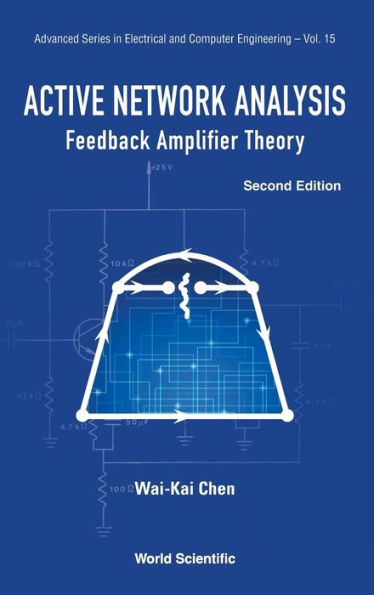Table of Contents
Preface to First Edition v
Preface to Second Edition ix
1 Characterizations of Networks 1
1.1 Linearity and Nonlinearity 2
1.2 Time Invariance and Time Variance 7
1.3 Passivity and Activity 9
1.4 Causality and Noncausality 15
1.5 Matrix Characterizations of n-Port Networks 22
1.6 Equivalent Frequency-Domain Conditions of Passivity 28
1.7 Discrete-Frequency Concepts of Passivity and Activity 39
1.8 Summary 61
Problems 62
Bibliography 70
2 The Indefinite-Admittance Matrix 72
2.3 The Indefinite-Admittance Matrix 72
2.2 Rules for Writing Down the Primitive Indefinite-Admittance Matrix 77
2.3 Terminal Contraction and Suppression 84
2.4 Interrelationships of Transistor Models 91
2.5 The First- and Second-Order Cofactors 102
2.6 Computation of Network Functions 105
2.7 Analysis of Constrained Active Networks 115
2.8 Generalized Norton's Theorem 131
2.9 Summary 136
Problems 137
Bibliography 145
3 Active Two-Port Networks 147
3.1 Two-Port Parameters 147
3.2 Power Gains 151
3.3 Sensitivity 153
3.4 Passivity and Activity 157
3.5 The U-Functions 162
3.6 Potential Instability and Absolute Stability 179
3.7 Optimum Terminations for Absolutely Stable Two-Port Networks 193
3.8 Summary 206
Problems 207
Bibliography 216
4 Theory of Feedback Amplifiers I 219
4.1 Ideal Feedback Model 220
4.2 Feedback Amplifier Configurations 222
4.3 General Feedback Theory 263
4.4 The Network Functions and Feedback 282
4.5 Summary 291
Problems 292
Bibliography 298
5 Theory of Feedback Amplifiers II 300
5.1 Sensitivity Function and Feedback 301
5.2 The Return Difference and Two-Port Functions 311
5.3 Return Difference and Null Return Difference with Respect to Two Elements 319
5.4 Extensions to Feedback Concepts 321
5.5 The Network Functions and General Return Difference and General Null Return Difference 327
5.6 The Relative Sensitivity Function and Feedback 336
5.7 Signal-Flow Graph Formulation of Feedback Amplifier Theory 341
5.8 Measurement of Return Difference 347
5.9 Considerations on the Invariance of Return Difference 358
5.10 Summary 372
Problems 374
Bibliography 380
6 Stability of Feedback Amplifiers 382
6.1 The Single-Loop Feedback Amplifiers 383
6.2 The Routh Criterion, the Hurwitz Criterion, and the Liénard-Chipart Criterion 384
6.3 The Nyquist Criterion 392
6.4 Applications of the Nyquist Criterion to Single-Loop Feedback Amplifiers 397
6.5 The Root-Locus Method 404
0.6 Root Sensitivity 423
6.7 Bode Formulas 429
6.8 Bode's Design Theory 442
6.9 Summary 452
Problems 454
Bibliography 460
7 Multiple-Loop Feedback Amplifiers 462
7.1 Matrix Signal-Flow Graphs 463
7.2 The Multiple-Loop Feedback Amplifier Theory 470
7.3 Extensions to Feedback Matrices 505
7.4 The Hybrid-Matrix Formulation of Multiple-Loop Feedback Theory 519
7.5 The Sensitivity Matrix and Multiparameter Sensitivity 529
7.6 Computation of Feedback Matrices 538
7.7 Summary 547
Problems 549
Bibliography 556
8 State-Space Analysis and Feedback Theory 559
8.1 State Equations in Normal Form 560
8.2 Graph Matrices and Kirchhoff's Equations 565
8.3 Trees and Fundamental Cutsets and Circuits 574
8.4 Systematic Procedure in Writing State Equations 584
8.5 State Equations for Degenerate Networks 601
8.6 State-Space Formulation of Feedback Theory 609
8.7 State-Space Formulation of Multiple-Loop Feedback Networks 632
8.8 Summary 649
Problems 651
Bibliography 655
9 Topological Analysis of Active Networks 657
9.1 Natural Frequencies 658
9.2 Digraph Associated with an Active Network 663
9.3 Order of Complexity 671
9.4 Unique Solvability 681
9.5 Topology and the Summation of Return Differences 697
9.6 Topological Analysis of Active Networks 719
9.7 Summary 732
Problems 734
Bibliography 735
10 Generalized Network Matrices and Their Cofactors 738
10.1 Network Determinants 739
10.2 Generalized Cofactors of the Generalized Network Matrix Determinants 757
10.3 The General Null Return Differences 765
10.4 Relations Between the Loop and Cutset Formulations 771
10.5 The Primary Systems of Equations 774
10.6 Invariance and Incidence Functions 775
10.7 Simple Derivations of Topological Formulas 779
10.8 Topological Evaluation of Feedback Matrices in Multiple-Loop Feedback Amplifiers 781
10.9 Summary 796
Bibliography 798
11 The Indefinite-Impedance Matrix Formulation of Feedback Amplifier Theory 800
11.1 The Indefinite-Impedance Matrix 801
11.2 Extension to Nonplanar Networks 816
11.3 Extension of a Dual Theorem on the Summation of Return Differences 820
11.4 Dual Topological Theorems of Linear Active Networks 826
11.5 Loop-Impedance Matrix Formulation 833
11.6 Summary 847
Bibliography 848
Appendices 851
I Hermilian Forms 851
II Conversion Chart for Two-Port Parameters 855
III Outline of a Derivation of Eq. (7.224) 856
Indexes
Symbol Index 859
Subject Index 862






